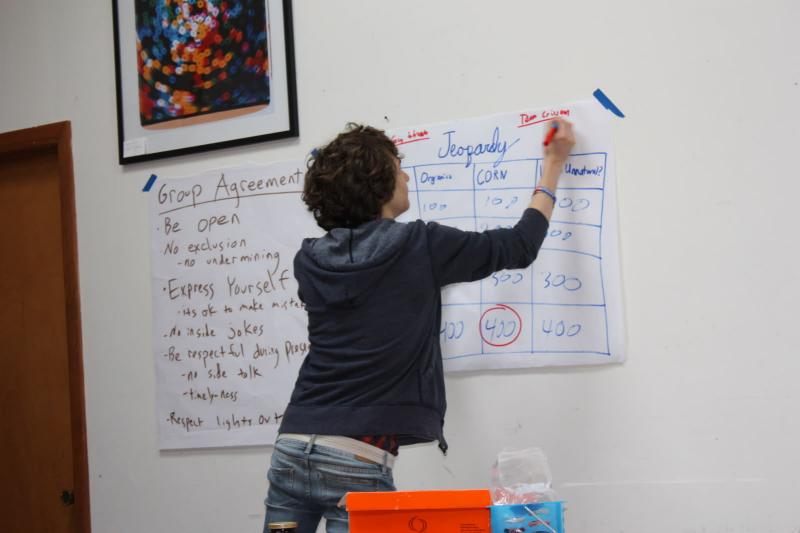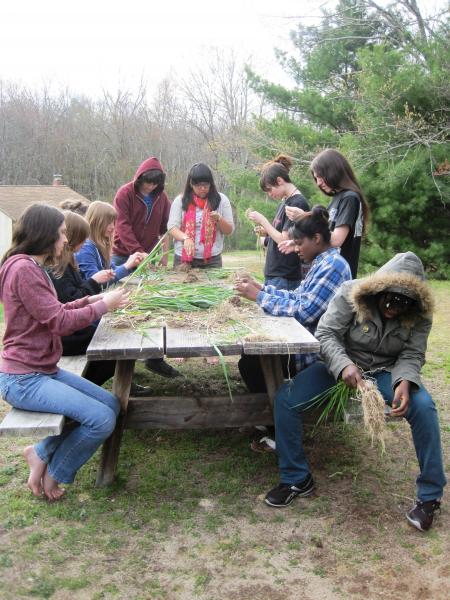Put the Movement Where Your Mouth Is


The YouthPeace Club put on its 13th annual YouthPeace Experiment April 29 through May 1 in Norwich, CT. YouthPeace is a Norwich Free Academy after-school group of youth who don’t accept war, racism, sexism, homophobia, or exploitation as facts of life. We work for nonviolent resolution of all conflicts from personal to international. A core focus of our work is counter-recruitment. YouthPeace has been a club at our high school since Patrick Sheehan-Gaumer and Matt Wiedenheft started it in 1999. This year, in addition to counter-recruitment and support for Muslim conscientious objectors in response to Islamophobia, the group wanted to learn about our food and where it comes from. So we organized this YouthPeace Experiment on “food justice.” It was about eating well, eating naturally, eating locally, and eating consciously.
Friday, the first night of the Experiment, we watched Robert Kenner’s Food, Inc., a documentary about America’s food—how it is produced and where it comes from. It was a good introduction to the topics we would be discussing over the next two days.
Saturday was the main day of the Experiment, with all our focus on food. We started the day with a tour of the Voluntown Peace Trust, where the Experiments are held. The tour was led by the trust’s facilities manager, Nancy, who has a long history of growing and preserving food. We were first led into a cramped greenhouse, where the gardening begins. Nancy then showed the group the fields where the crops are grown, and what kinds of vegetables, herbs, and fruits are grown there. We asked lots of questions, including how to do some of this in our own yards.
All of Saturday’s workshops were completely assembled and led by YouthPeace members, which is a first for a YouthPeace Experiment. Students, who suggested doing it this way, had to put in time before the weekend, despite our busy work schedules, to research and come up with activities centered on their topics.

I did a workshop based on the definition of the word “natural” on food labels. To test the group’s collective knowledge on the definitions of different food labels (e.g., organic, natural), I separated the group into two teams and pitted them against each other in a Jeopardy-style game. Categories included Organics, Natural or Not?, and Corn. The teams were asked a variety of questions from these categories and received points if they answered these questions correctly. If they answered incorrectly, the other team was given the opportunity to answer the question for points. The questions were not simple yes-or-no questions; in fact, they were quite in depth. The final question was “How does corn degrade the world economy?” The winning team didn’t receive anything as a prize, but both teams gained a wealth of knowledge regarding where their food comes from.
Paige McElroy focused on food ethics and hardships faced by those who pick our food. She read us stories about farm workers and their families and then broke us into three groups. Each group was assigned a scenario to act out based on one of the stories. My group had to exemplify through a skit the neglected children of parents who made a meager living by working all day in the fields. In our skit, the parents left to go out to work for the day, and the kids were involved in gang activity and with drugs. Another group showed a banana plantation worker getting sprayed with the carcinogenic pesticides used openly and freely on the plantations and the health problems that followed. All of these skits were fun to put on as well as funny, but each carried a serious message about the people portrayed and what they go through daily to give us the cheap, convenient food we’re accustomed to.
Tonay Gooday-Ervin presented on the environmental effects of monoculture (only growing one kind of crop) and the effects of pesticides in the environment. She shared broad knowledge that she’d gained all year in an environmental sciences class. The lecture-type discussion gave the group a much greater understanding of how humans affect the earth through “misagriculture.”
The final workshop, led by Kat Moroch, used a poster board display that featured grotesquely enlightening pictures of how animals are treated in the food industry and information about how we can boycott these inhumane practices. Kat then led a heated discussion on vegetarianism versus a diet featuring meat.
Later in the day, we were given the opportunity to help make our own healthy food. Rick Gaumer, the cook for the YouthPeace Experiments, brought in some young garlic from his own garden. Joanne Sheehan taught the group how to prepare them, and together we made a spicy garlic pesto with the young garlic, spinach, and olive oil. We had that with pasta and optional cheese so the dish could be vegan friendly.
On Sunday, YouthPeace participated in the work day at the Voluntown Peace Trust. This involved raking leaves and pine needles. Some even got to till land in the garden! We spent the rest of our time talking about what we could do to improve the club and the Experiment for next year with community mentor Patrick Sheehan-Gaumer. We definitely want to do student-led workshops in the future.
The Experiment has really changed the way I make decisions about how I eat. I now check labels religiously for ingredients mislabeled as “natural” or “organic,” the origins of the food I eat, and how all of these things influence my health and my community. This three-day weekend completely changed my perception of food and showed me what really goes on in our food industry and how I can start to change it. I believe it’s our right to know what we eat and how it affects us, and learning about all of this and making a change takes much less time than an entire weekend.
Garlic Greens Pesto

This spring pesto recipe is from Juanita Nelson. If you grow garlic, some may flower and go to seed. We enjoy this kind of pesto so much we intentionally let some garlic go to seed for the spring greens. In early spring, pull or dig them up when they are 5 or 6 inches or so —before they get tough and stringy. To prepare, just cut off the roots. The garlic greens give you both the garlic taste and the green for pesto—no need for other greens, although adding baby spring spinach gives this pesto a richer taste. Just add more olive oil for a smooth paste.
1 bunch of garlic greens (2 cups chopped and packed)
spinach greens
2/3 cups olive oil
2/3 cup walnuts
1/2 to 2/3 cup parmesan cheese (I prefer to add this later, so the taste complements the green pesto rather than getting lost.)
Combine the first 3 ingredients thoroughly in a food processor until a smooth paste is formed. This can be frozen to enjoy all year long, or, kept in the fridge covered in a thin layer of olive oil, it will last for weeks. Use on pasta, rice, crackers, or bread; sprinkle with parmesan cheese.
Submitted by Joanne Sheehan
